manual transmission JEEP WRANGLER 2010 Owners Manual
[x] Cancel search | Manufacturer: JEEP, Model Year: 2010, Model line: WRANGLER, Model: JEEP WRANGLER 2010Pages: 554, PDF Size: 10.16 MB
Page 149 of 554
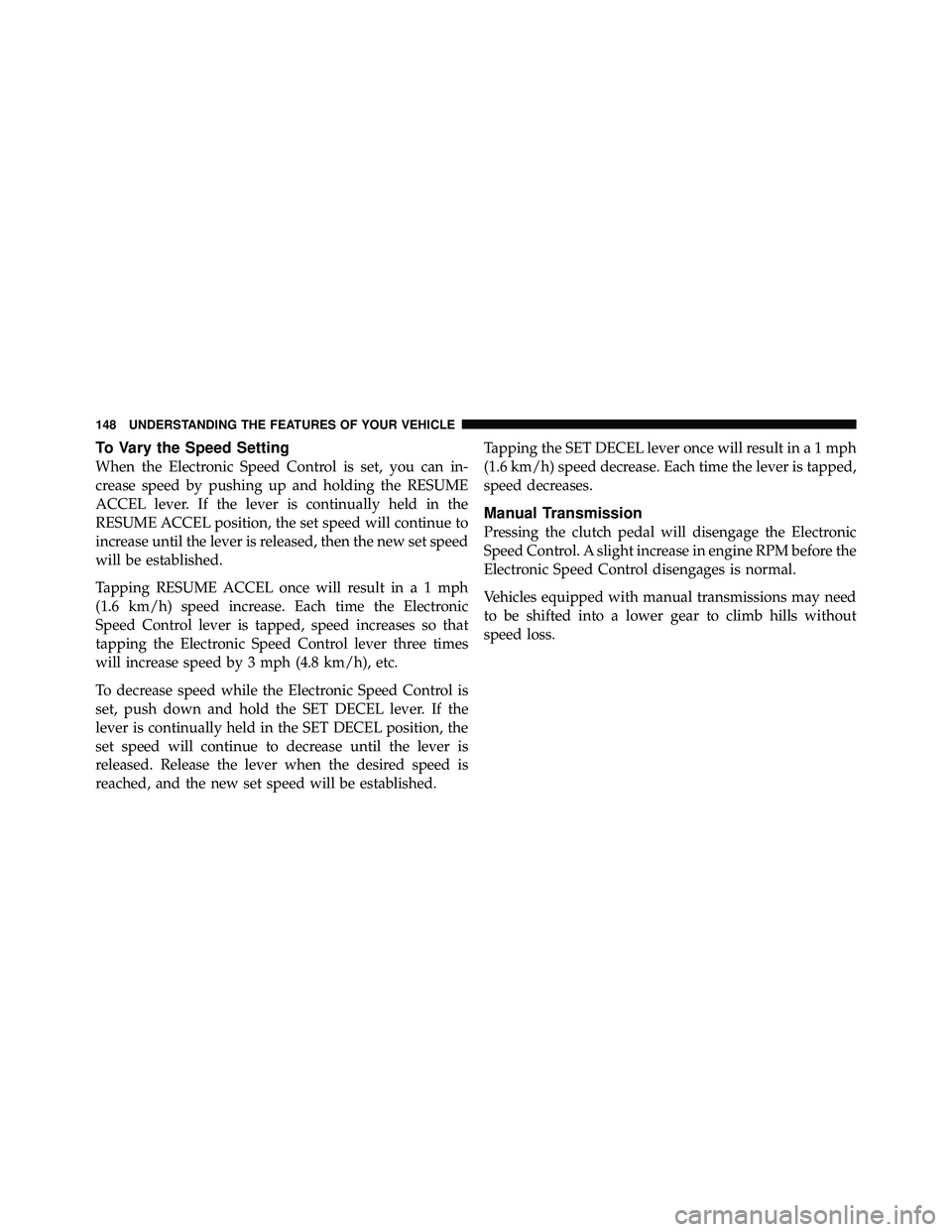
To Vary the Speed Setting
When the Electronic Speed Control is set, you can in-
crease speed by pushing up and holding the RESUME
ACCEL lever. If the lever is continually held in the
RESUME ACCEL position, the set speed will continue to
increase until the lever is released, then the new set speed
will be established.
Tapping RESUME ACCEL once will result ina1mph
(1.6 km/h) speed increase. Each time the Electronic
Speed Control lever is tapped, speed increases so that
tapping the Electronic Speed Control lever three times
will increase speed by 3 mph (4.8 km/h), etc.
To decrease speed while the Electronic Speed Control is
set, push down and hold the SET DECEL lever. If the
lever is continually held in the SET DECEL position, the
set speed will continue to decrease until the lever is
released. Release the lever when the desired speed is
reached, and the new set speed will be established.Tapping the SET DECEL lever once will result ina1mph
(1.6 km/h) speed decrease. Each time the lever is tapped,
speed decreases.
Manual Transmission
Pressing the clutch pedal will disengage the Electronic
Speed Control. A slight increase in engine RPM before the
Electronic Speed Control disengages is normal.
Vehicles equipped with manual transmissions may need
to be shifted into a lower gear to climb hills without
speed loss.
148 UNDERSTANDING THE FEATURES OF YOUR VEHICLE
Page 337 of 554
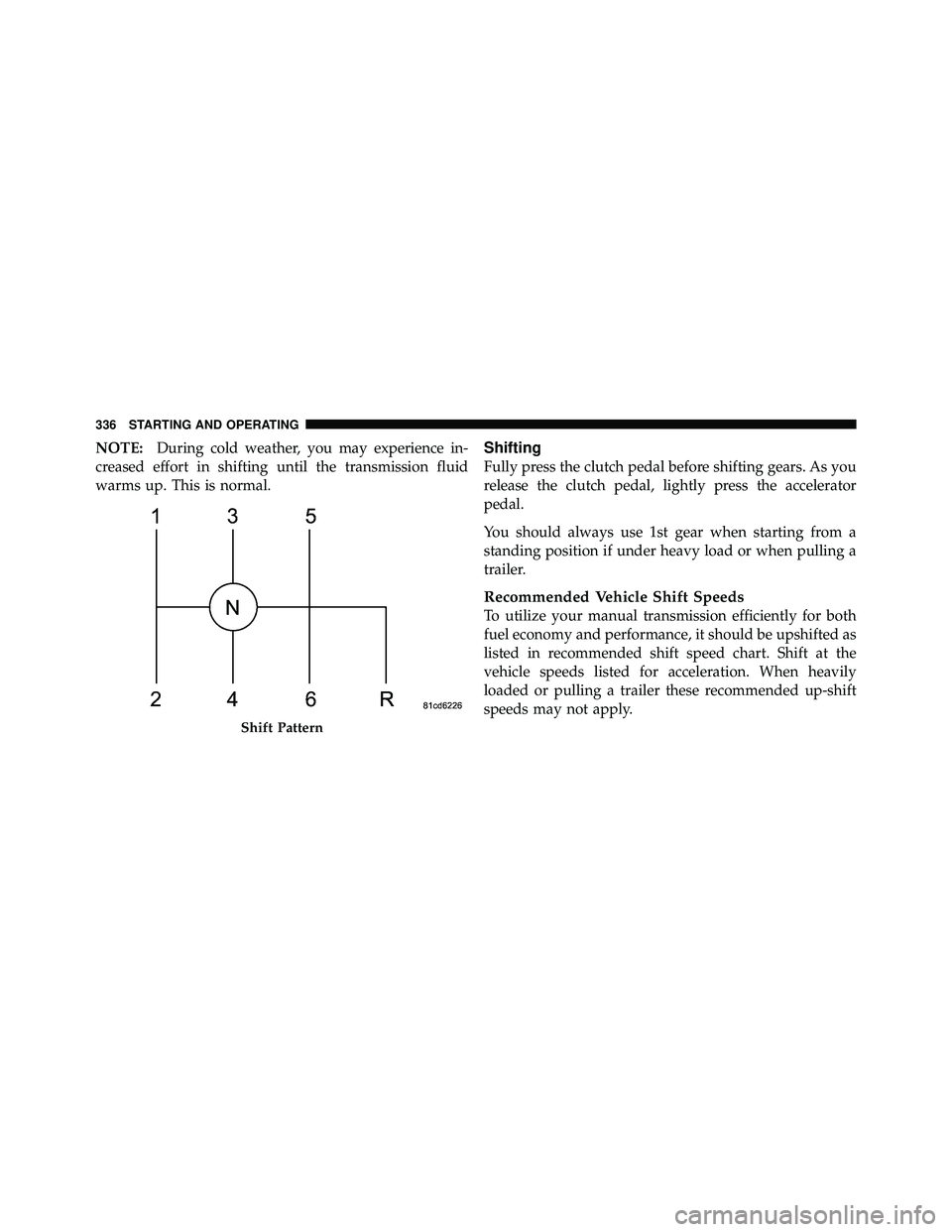
NOTE:During cold weather, you may experience in-
creased effort in shifting until the transmission fluid
warms up. This is normal.Shifting
Fully press the clutch pedal before shifting gears. As you
release the clutch pedal, lightly press the accelerator
pedal.
You should always use 1st gear when starting from a
standing position if under heavy load or when pulling a
trailer.
Recommended Vehicle Shift Speeds
To utilize your manual transmission efficiently for both
fuel economy and performance, it should be upshifted as
listed in recommended shift speed chart. Shift at the
vehicle speeds listed for acceleration. When heavily
loaded or pulling a trailer these recommended up-shift
speeds may not apply.
Page 341 of 554
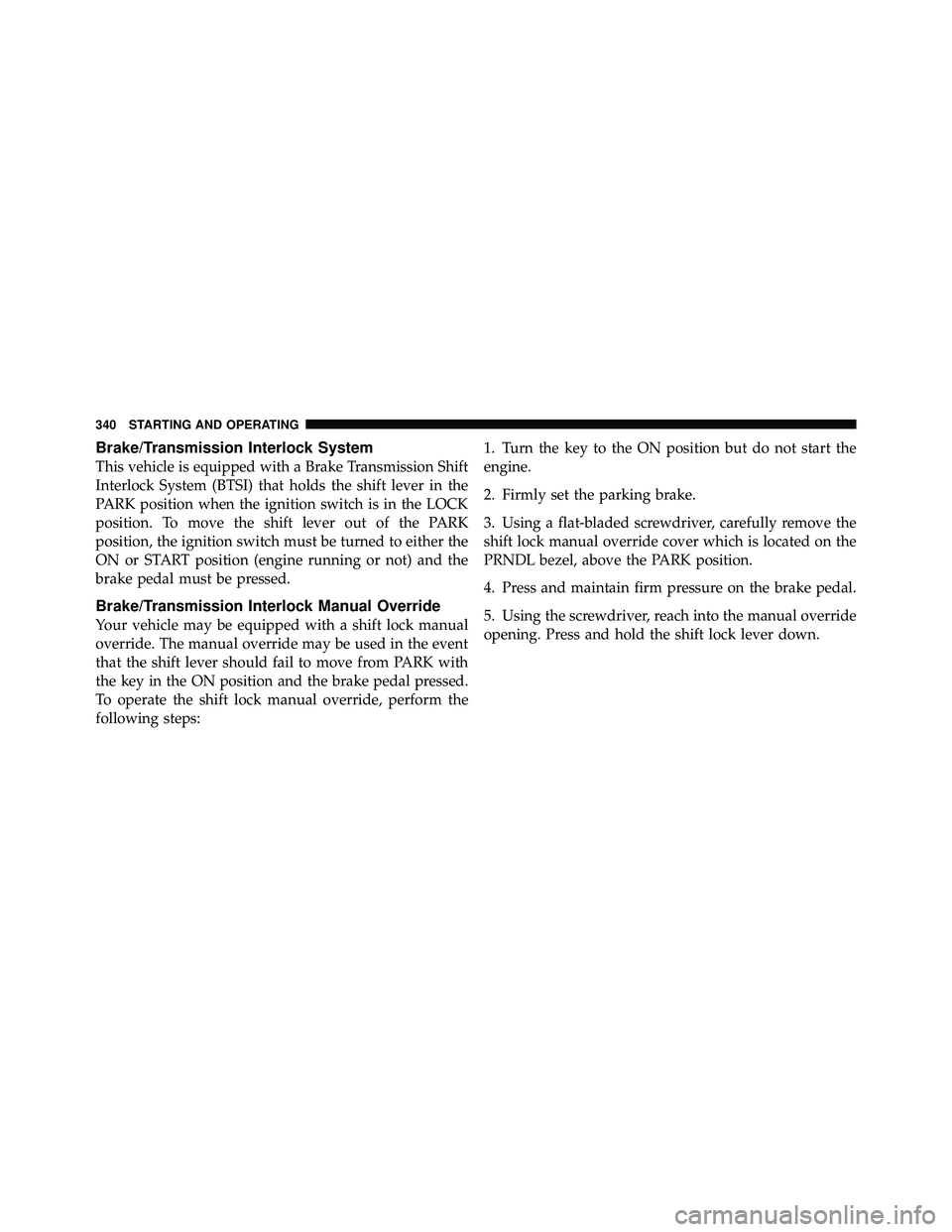
Brake/Transmission Interlock System
This vehicle is equipped with a Brake Transmission Shift
Interlock System (BTSI) that holds the shift lever in the
PARK position when the ignition switch is in the LOCK
position. To move the shift lever out of the PARK
position, the ignition switch must be turned to either the
ON or START position (engine running or not) and the
brake pedal must be pressed.
Brake/Transmission Interlock Manual Override
Your vehicle may be equipped with a shift lock manual
override. The manual override may be used in the event
that the shift lever should fail to move from PARK with
the key in the ON position and the brake pedal pressed.
To operate the shift lock manual override, perform the
following steps:1. Turn the key to the ON position but do not start the
engine.
2. Firmly set the parking brake.
3. Using a flat-bladed screwdriver, carefully remove the
shift lock manual override cover which is located on the
PRNDL bezel, above the PARK position.
4. Press and maintain firm pressure on the brake pedal.
5. Using the screwdriver, reach into the manual override
opening. Press and hold the shift lock lever down.
340 STARTING AND OPERATING
Page 365 of 554
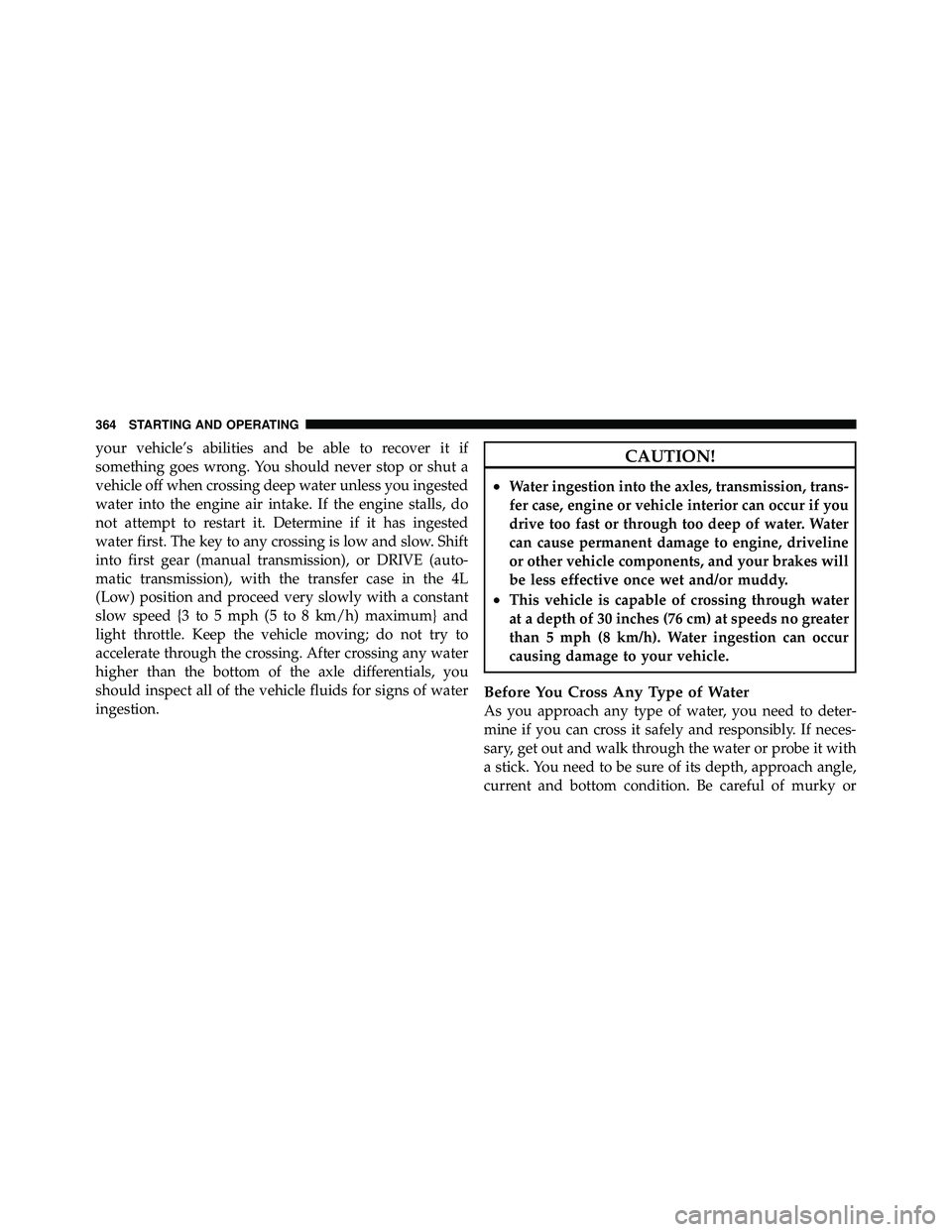
your vehicle’s abilities and be able to recover it if
something goes wrong. You should never stop or shut a
vehicle off when crossing deep water unless you ingested
water into the engine air intake. If the engine stalls, do
not attempt to restart it. Determine if it has ingested
water first. The key to any crossing is low and slow. Shift
into first gear (manual transmission), or DRIVE (auto-
matic transmission), with the transfer case in the 4L
(Low) position and proceed very slowly with a constant
slow speed {3 to 5 mph (5 to 8 km/h) maximum} and
light throttle. Keep the vehicle moving; do not try to
accelerate through the crossing. After crossing any water
higher than the bottom of the axle differentials, you
should inspect all of the vehicle fluids for signs of water
ingestion.
Page 377 of 554
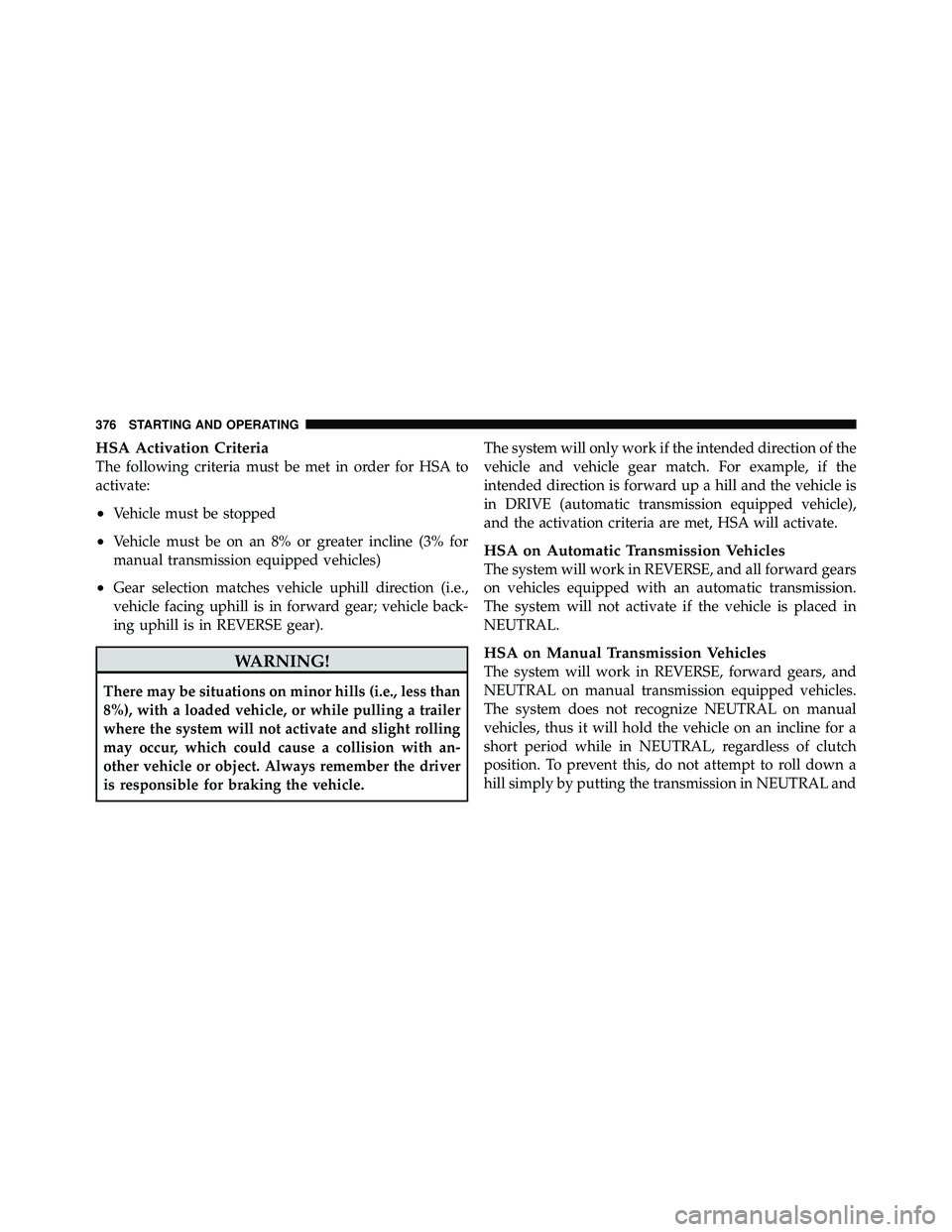
HSA Activation Criteria
The following criteria must be met in order for HSA to
activate:
•Vehicle must be stopped
•Vehicle must be on an 8% or greater incline (3% for
manual transmission equipped vehicles)
•Gear selection matches vehicle uphill direction (i.e.,
vehicle facing uphill is in forward gear; vehicle back-
ing uphill is in REVERSE gear).
Page 379 of 554
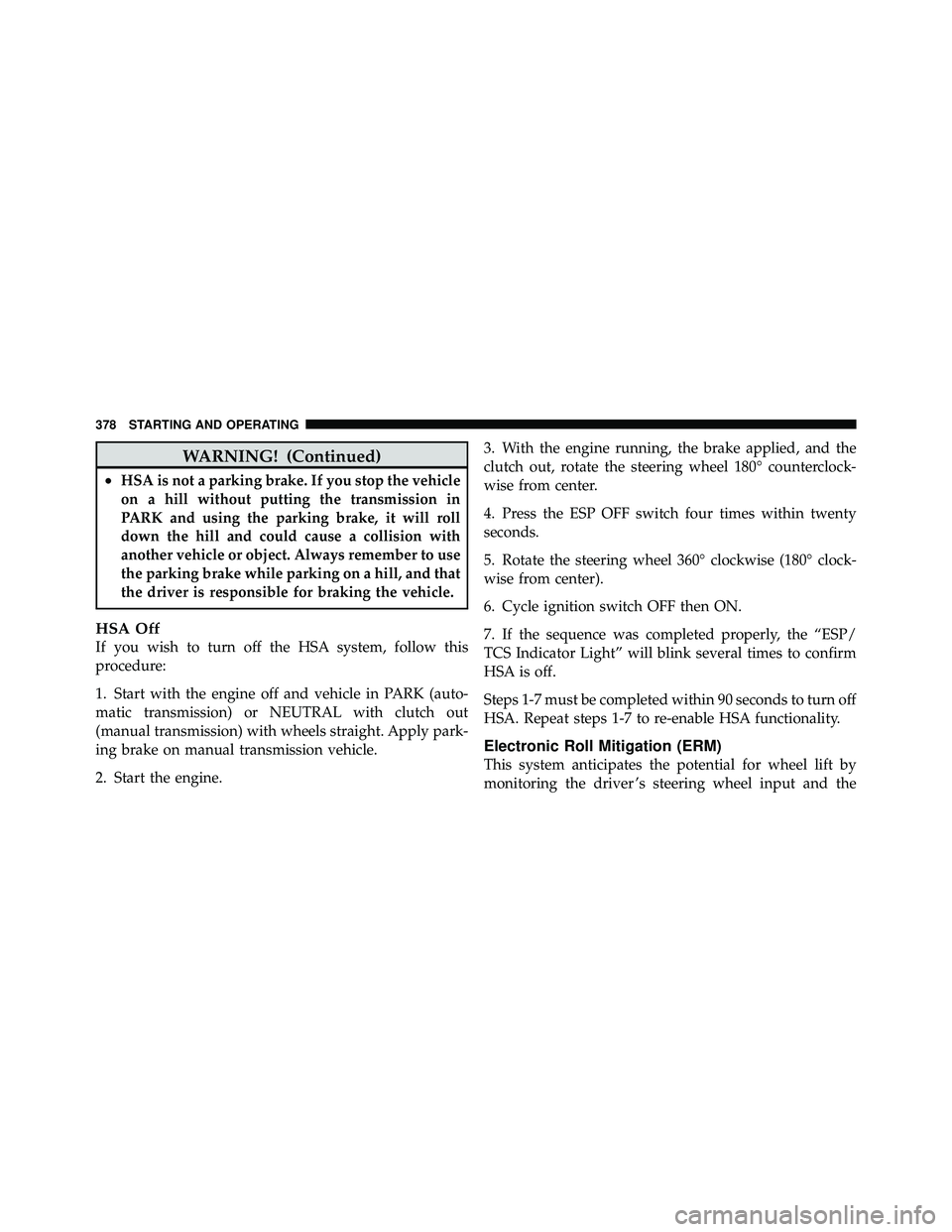
WARNING! (Continued)
•HSA is not a parking brake. If you stop the vehicle
on a hill without putting the transmission in
PARK and using the parking brake, it will roll
down the hill and could cause a collision with
another vehicle or object. Always remember to use
the parking brake while parking on a hill, and that
the driver is responsible for braking the vehicle.
HSA Off
If you wish to turn off the HSA system, follow this
procedure:
1. Start with the engine off and vehicle in PARK (auto-
matic transmission) or NEUTRAL with clutch out
(manual transmission) with wheels straight. Apply park-
ing brake on manual transmission vehicle.
2. Start the engine.3. With the engine running, the brake applied, and the
clutch out, rotate the steering wheel 180° counterclock-
wise from center.
4. Press the ESP OFF switch four times within twenty
seconds.
5. Rotate the steering wheel 360° clockwise (180° clock-
wise from center).
6. Cycle ignition switch OFF then ON.
7. If the sequence was completed properly, the “ESP/
TCS Indicator Light” will blink several times to confirm
HSA is off.
Steps 1-7 must be completed within 90 seconds to turn off
HSA. Repeat steps 1-7 to re-enable HSA functionality.
Electronic Roll Mitigation (ERM)
This system anticipates the potential for wheel lift by
monitoring the driver ’s steering wheel input and the
378 STARTING AND OPERATING
Page 427 of 554
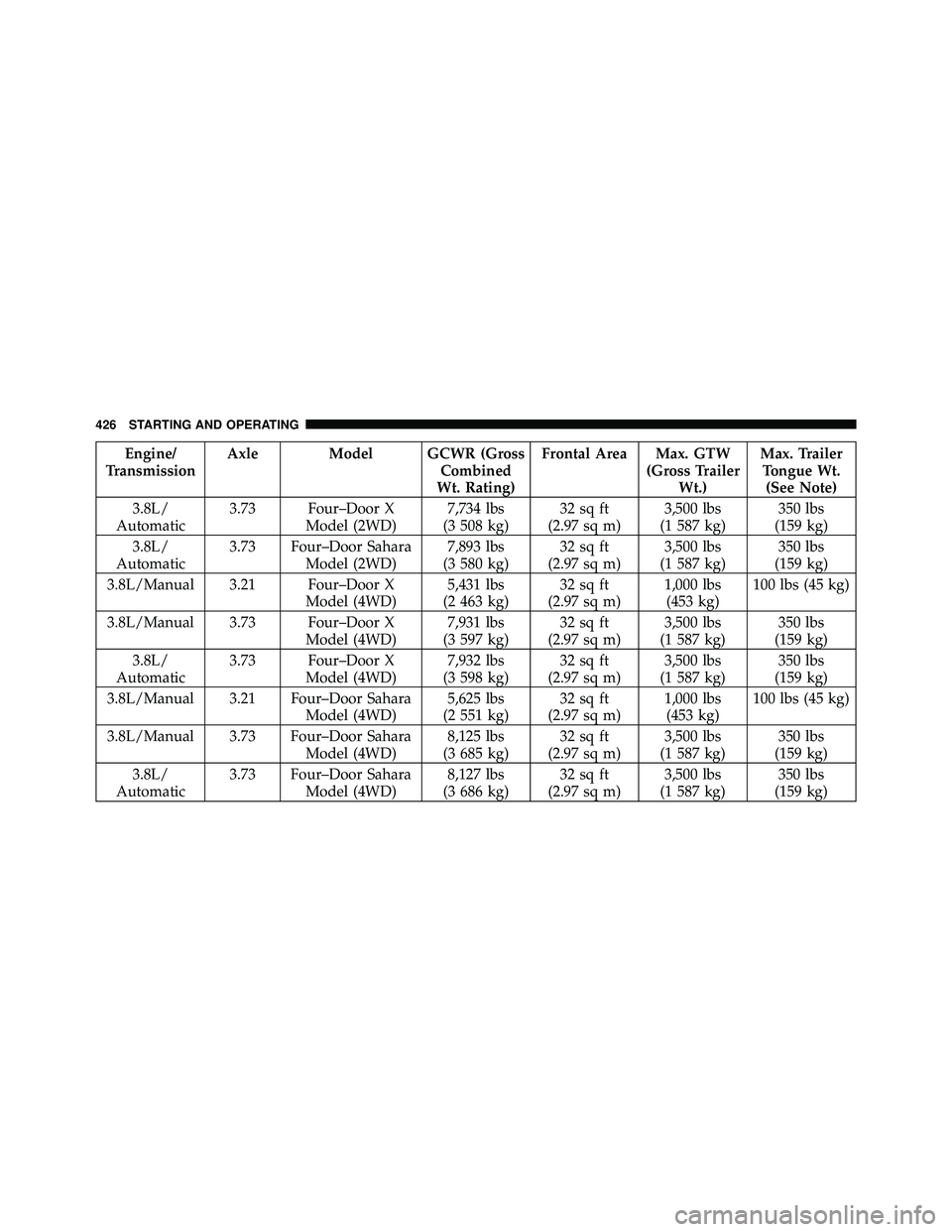
Engine/
Transmission Axle Model GCWR (Gross
Combined
Wt. Rating) Frontal Area Max. GTW
(Gross TrailerWt.) Max. Trailer
Tongue Wt. (See Note)
3.8L/
Automatic 3.73 Four–Door X
Model (2WD) 7,734 lbs
(3 508 kg) 32 sq ft
(2.97 sq m) 3,500 lbs
(1 587 kg) 350 lbs
(159 kg)
3.8L/
Automatic 3.73 Four–Door Sahara
Model (2WD) 7,893 lbs
(3 580 kg) 32 sq ft
(2.97 sq m) 3,500 lbs
(1 587 kg) 350 lbs
(159 kg)
3.8L/Manual 3.21 Four–Door X Model (4WD)5,431 lbs
(2 463 kg) 32 sq ft
(2.97 sq m) 1,000 lbs
(453 kg) 100 lbs (45 kg)
3.8L/Manual 3.73 Four–Door X Model (4WD)7,931 lbs
(3 597 kg) 32 sq ft
(2.97 sq m) 3,500 lbs
(1 587 kg) 350 lbs
(159 kg)
3.8L/
Automatic 3.73 Four–Door X
Model (4WD) 7,932 lbs
(3 598 kg) 32 sq ft
(2.97 sq m) 3,500 lbs
(1 587 kg) 350 lbs
(159 kg)
3.8L/Manual 3.21 Four–Door Sahara Model (4WD)5,625 lbs
(2 551 kg) 32 sq ft
(2.97 sq m) 1,000 lbs
(453 kg) 100 lbs (45 kg)
3.8L/Manual 3.73 Four–Door Sahara Model (4WD)8,125 lbs
(3 685 kg) 32 sq ft
(2.97 sq m) 3,500 lbs
(1 587 kg) 350 lbs
(159 kg)
3.8L/
Automatic 3.73 Four–Door Sahara
Model (4WD) 8,127 lbs
(3 686 kg) 32 sq ft
(2.97 sq m) 3,500 lbs
(1 587 kg) 350 lbs
(159 kg)
426 STARTING AND OPERATING
Page 431 of 554
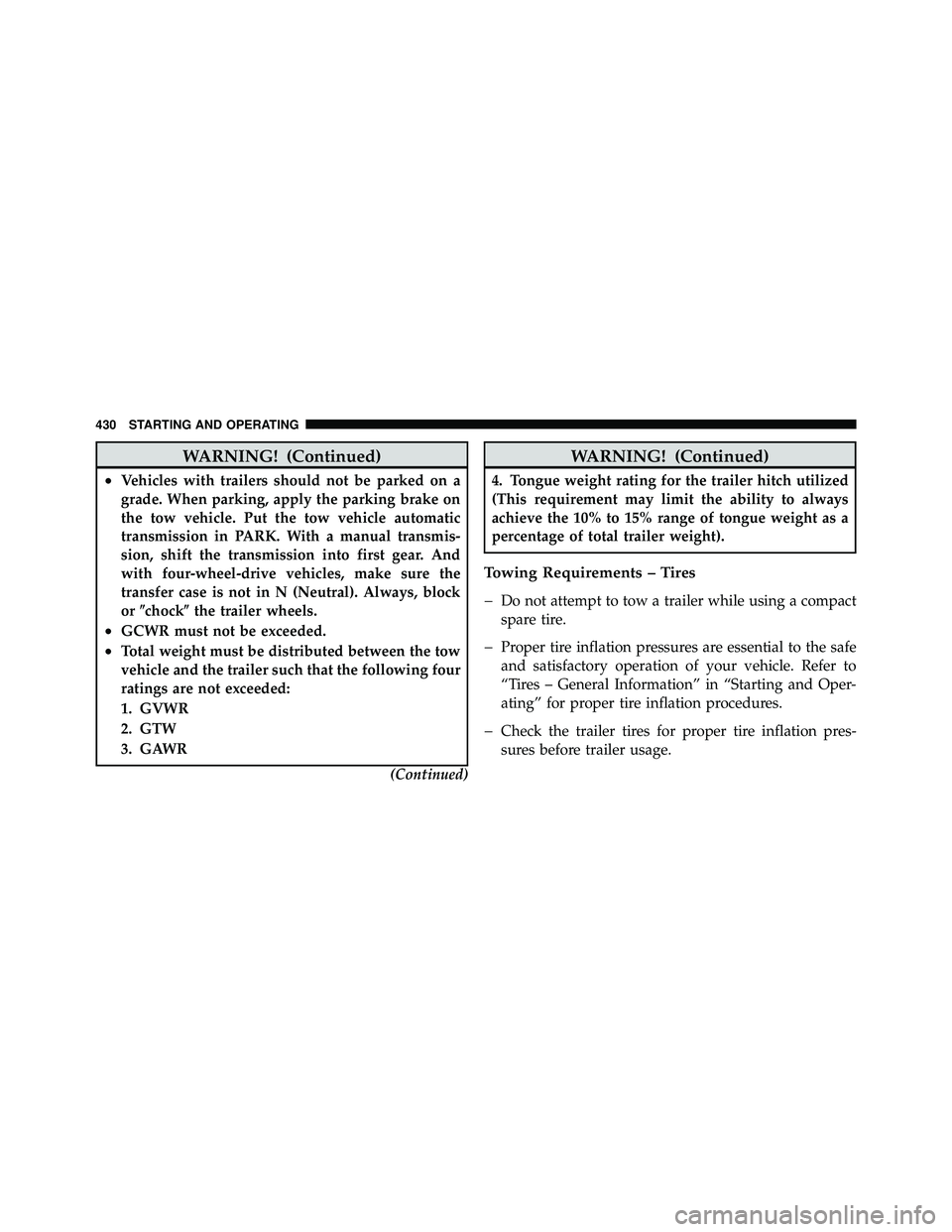
WARNING! (Continued)
•Vehicles with trailers should not be parked on a
grade. When parking, apply the parking brake on
the tow vehicle. Put the tow vehicle automatic
transmission in PARK. With a manual transmis-
sion, shift the transmission into first gear. And
with four-wheel-drive vehicles, make sure the
transfer case is not in N (Neutral). Always, block
or\bchock\b the trailer wheels.
•GCWR must not be exceeded.
•Total weight must be distributed between the tow
vehicle and the trailer such that the following four
ratings are not exceeded:
1. GVWR
2. GTW
3. GAWR
(Continued)
Page 437 of 554
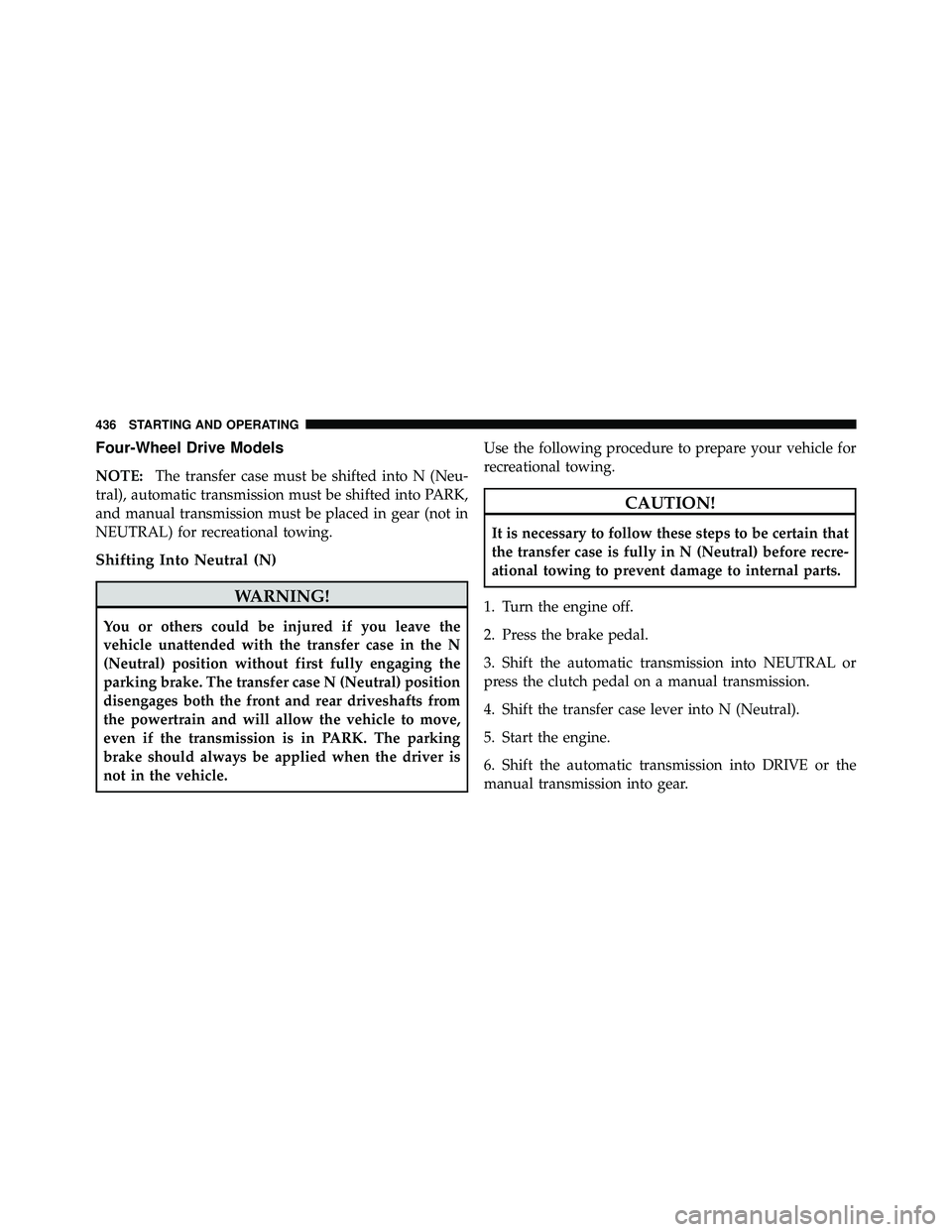
Four-Wheel Drive Models
NOTE:The transfer case must be shifted into N (Neu-
tral), automatic transmission must be shifted into PARK,
and manual transmission must be placed in gear (not in
NEUTRAL) for recreational towing.
Shifting Into Neutral (N)
Page 439 of 554
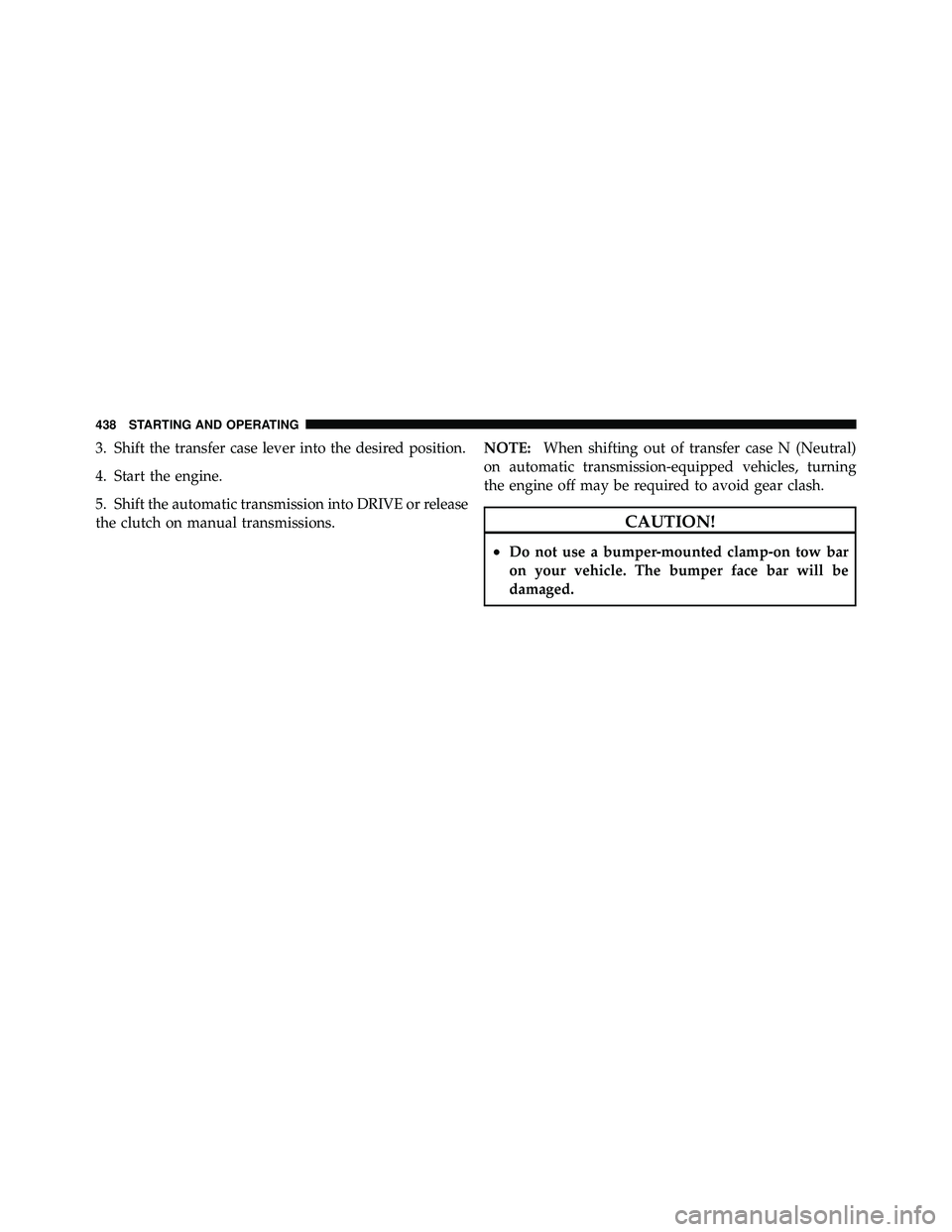
3. Shift the transfer case lever into the desired position.
4. Start the engine.
5. Shift the automatic transmission into DRIVE or release
the clutch on manual transmissions.NOTE:
When shifting out of transfer case N (Neutral)
on automatic transmission-equipped vehicles, turning
the engine off may be required to avoid gear clash.